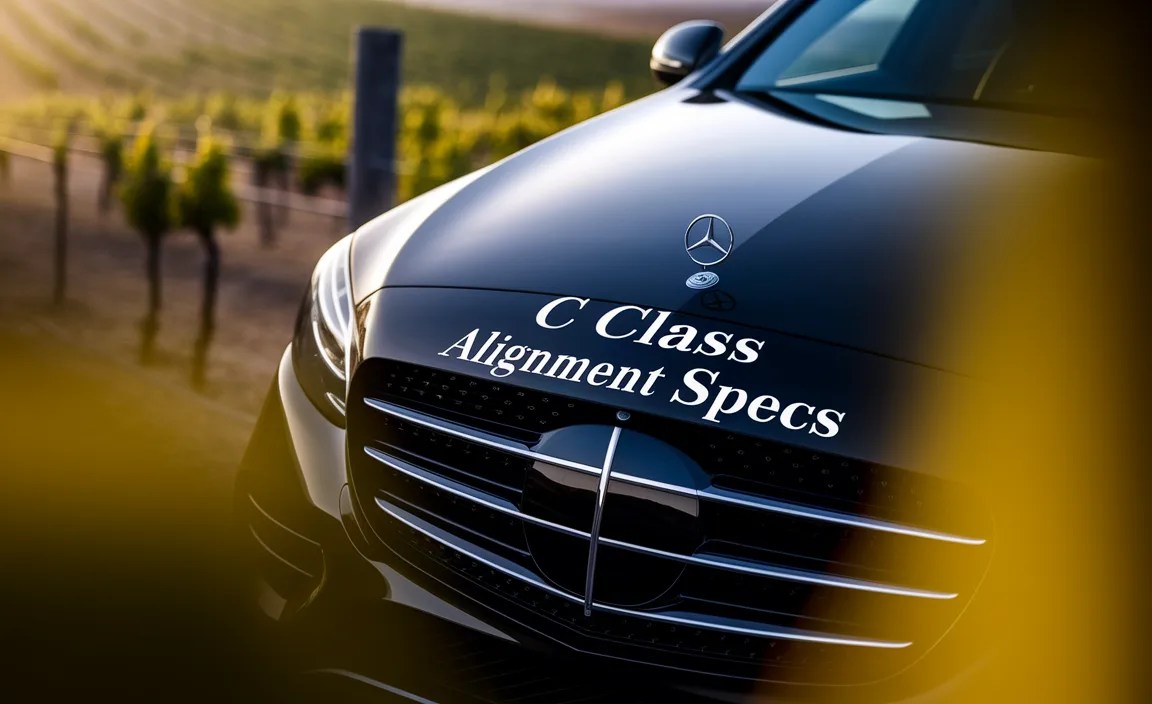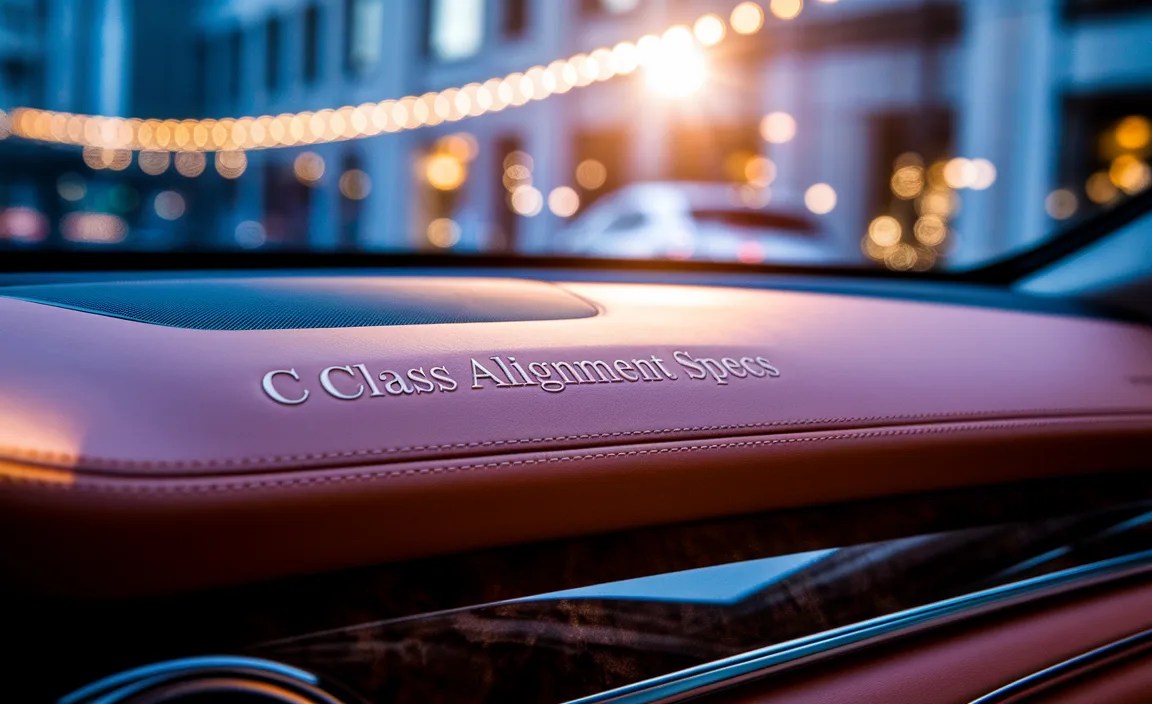C Class Alignment Specs: Perfect Handling
Achieving perfect handling in your Mercedes-Benz C-Class starts with precise alignment. Understanding C Class alignment specs—including camber, caster, and toe—ensures optimal tire wear, balanced stability, and responsive steering. Proper alignment is crucial for a smooth, safe, and enjoyable driving experience.

Your Mercedes-Benz C-Class is a masterpiece of German engineering, designed for exquisite comfort and dynamic performance. But even the most sophisticated car can feel a bit “off” if its wheel alignment isn’t quite right. You might notice your car pulling to one side, the steering wheel feeling loose, or uneven tire wear. These are common frustrations that can diminish the joy of driving your luxury sedan. Don’t worry, getting your C-Class alignment back in spec is straightforward once you understand what to look for. This guide will break down exactly what C Class alignment specs mean and how they contribute to that signature Mercedes-Benz handling you love.
We’ll cover the key alignment angles, why they matter, and what you should expect when you take your C-Class in for service. By the end of this article, you’ll be empowered to discuss alignment with your technician and ensure your vehicle performs at its peak, providing you with the confidence and comfort only a Mercedes-Benz can deliver.
Understanding Wheel Alignment: The Foundation of C-Class Handling
Wheel alignment is a critical, yet often overlooked, aspect of vehicle maintenance. It’s not about the wheels themselves being crooked, but rather the angles at which they are set in relation to the car and the road. Think of it as the car’s posture; just like a person stands straighter and moves better with good posture, a car handles better when its wheels are properly aligned.
For a C-Class, which is engineered for a blend of sporty agility and luxurious comfort, correct alignment is paramount. It directly impacts:
- Handling and Steering Response: Proper alignment ensures your car steers predictably and responds accurately to your input.
- Tire Longevity: Misaligned wheels can cause tires to scrub or drag, leading to premature and uneven wear, costing you money and reducing grip.
- Fuel Efficiency: Tires that are fighting against each other due to poor alignment create unnecessary rolling resistance, consuming more fuel.
- Driving Stability: Correct alignment contributes significantly to the car’s stability, especially at higher speeds and during cornering.
- Ride Comfort: A well-aligned car will feel smoother and more composed on the road, enhancing the overall driving experience.
When we talk about C Class alignment specs, we’re referring to a set of precise measurements for these angles. These specifications are determined by Mercedes-Benz engineers to optimize the balance between performance, comfort, and tire life for each specific C-Class model and generation.
The Three Pillars of C-Class Alignment: Camber, Caster, and Toe
Wheel alignment is primarily defined by three key angles. Understanding these will help you grasp what your mechanic is checking and why it’s important for your C-Class. Each angle plays a distinct role, and they work in harmony to provide optimal handling.

1. Camber: The Tire’s Angle When Viewed From the Front
Camber refers to the inward or outward tilt of your C-Class’s wheels when viewed from the front of the vehicle. It’s measured in degrees.
- Negative Camber: The top of the wheel tilts inward, towards the center of the car. This can improve cornering grip by keeping the tire more perpendicular to the road surface during a turn.
- Positive Camber: The top of the wheel tilts outward, away from the car. This is less common on modern passenger cars like the C-Class but can aid straight-line stability.
- Zero Camber: The wheel is perfectly vertical.
On a C-Class, you’ll typically find slightly negative camber settings, especially on the front wheels. This setup is a compromise: it aids cornering performance but can lead to some inner tire wear if not properly balanced with other alignment settings. The specific degrees are meticulously calculated by Mercedes-Benz engineers for the best all-around performance.
2. Caster: The Steering Axis Angle
Caster describes the angle of the steering axis when viewed from the side of the vehicle. It’s the angle of the upper pivot point (like the ball joint or strut mount) relative to the lower one. Caster affects:
- Steering Stability: Positive caster (where the steering axis leans backward) helps the wheels return to center after a turn, like the wheels on a shopping cart always trailing behind. This adds stability at higher speeds.
- Steering Effort: Increased positive caster generally increases steering “feel” and effort, which is desirable for a sporty car like the C-Class.
- Handling Balance: Caster also plays a role in how the car handles during cornering and braking.
Most C-Class models will have positive caster for better steering feel and self-centering. The precise caster specification ensures that the steering feels precise and planted, without being overly heavy for daily driving.
3. Toe: The Tire’s Angle When Viewed From Above
Toe refers to the direction in which the tires are pointing when viewed from above. It’s like looking down at your feet; if your toes point slightly inward, that’s “toe-in”; if they point slightly outward, that’s “toe-out.”
- Toe-In: The front edges of the tires are closer together than the rear edges. This setting tends to improve straight-line stability and can counter unwanted turning forces.
- Toe-Out: The front edges of the tires are further apart than the rear edges. This can make the car feel more responsive and eager to turn into corners, often used on performance-oriented vehicles.
- Zero Toe: The tires are pointing perfectly straight ahead.
For a front-wheel-drive or rear-wheel-drive car like the C-Class, the specifications will vary slightly between the front and rear axles. Front wheels often have a slight toe-in or near-zero toe to promote stability, while rear wheels might have a slight toe-in for stability during acceleration and braking. Modern multi-link suspensions can also introduce dynamic toe changes as the suspension compresses and extends, which engineers factor into the static alignment settings.
C Class Alignment Specs: What to Expect for Your Model
The exact alignment specifications for a Mercedes-Benz C-Class can vary significantly based on the specific model year, chassis designation (e.g., W205, W206), and even whether it’s a standard sedan, an AMG variant, or equipped with specific optional suspension packages. Mercedes-Benz sets these specifications to achieve the intended driving dynamics for each variant.

While providing a comprehensive list for every single C-Class ever made would be extensive, here are typical ranges and considerations for common generations. It’s crucial to always refer to your specific vehicle’s service manual or consult with a qualified Mercedes-Benz technician for the precise values.
General C Class Alignment Specs (Typical Values – Consult Service Manual for Exact Specs)
These are general figures and may not apply to all models or trims. Always verify with official Mercedes-Benz documentation for your specific vehicle.
| Alignment Angle | Front Axle (Typical Range) | Rear Axle (Typical Range) | Notes |
|---|---|---|---|
| Camber | |||
| Left/Right | -0.75° to -1.50° | -1.00° to -1.75° | Slightly negative camber aids cornering grip. |
| Total | -1.00° to -2.25° | -1.50° to -2.50° | Total difference should be minimal. |
| Caster | |||
| Left/Right | +7.0° to +9.0° | N/A (Not Adjustable on most models) | Positive caster enhances straight-line stability and steering feel. |
| Total | +0.5° to +1.5° | N/A | Total difference should be minimal. |
| Toe | |||
| Total (Front) | 0.05° to 0.15° (Toe-In) | N/A | Slight toe-in promotes straight-line stability. |
| Individual (Front Left/Right) | +/- 0.05° | N/A | Ensure minimal difference between sides. |
| Total (Rear) | N/A | 0.10° to 0.25° (Toe-In) | Toe-in on rear wheels provides stability under acceleration/braking. |
| Individual (Rear Left/Right) | N/A | +/- 0.05° | Ensure minimal difference between sides. |
Important Considerations:
- AMG Models: Performance-oriented AMG variants often have more aggressive alignment settings, typically with more negative camber and slightly different toe angles to maximize grip during spirited driving.
- Sport vs. Comfort Suspension: Different suspension options from the factory can influence the target alignment values.
- Tire Size and Type: The type of tires fitted (e.g., performance summer tires vs. all-season) can also play a role in the ideal alignment.
- Adjustability: While camber angles are generally adjustable on C-Class models, caster is often fixed unless specific aftermarket adjustable components are installed. Rear toe is usually adjustable.
If you’re unsure, always ask your technician to print out the alignment sheet with the “before” and “after” measurements, and specifically display the OEM (Original Equipment Manufacturer) specifications that were targeted.
Why C Class Alignment Specs Matter for Safety and Performance
Misalignment isn’t just an annoyance; it can compromise the core attributes of your C-Class that you paid for: safety, performance, and luxury comfort. Let’s delve deeper into why adhering to the correct C Class alignment specs is so vital.

Safety First: Preventing Unpredictable Behavior
A misaligned C-Class can behave unpredictably, especially in critical situations. Imagine braking hard or swerving to avoid an obstacle. If your wheels are not tracking correctly:
- Instability: The car might dart or pull unexpectedly, making it harder to control.
- Reduced Braking Effectiveness: Uneven tire contact can lead to less efficient braking.
- Compromised ABS/ESP: Modern stability and anti-lock braking systems rely on accurate wheel speed and direction data. Misalignment can interfere with their proper functioning.
Mercedes-Benz vehicles are designed with advanced safety systems. Ensuring the mechanical aspect—your alignment—is perfect allows these systems to operate as intended, keeping you and your passengers safer.
Performance Purity: The AMG Experience
For AMG C-Class owners, alignment is not just about stability; it’s about maximizing performance. These cars are tuned for incredibly responsive handling. The engineers meticulously set the alignment parameters to:
- Optimize Tire Contact Patch: Ensuring the tire is making maximum contact with the road during hard cornering.
- Provide Crisp Turn-In: Allowing the car to change direction quickly and precisely.
- Maintain Grip Under Load: So you can accelerate out of corners with confidence.
Deviating from AMG-specific C Class alignment specs can dramatically reduce the car’s performance potential and negatively impact the exhilarating driving experience it’s known for.
Economical Ownership: Saving Money on Tires and Fuel
Beyond the immediate driving experience, proper alignment is a smart financial decision. You’ve invested in a premium vehicle; let’s keep its running costs in check:
- Tire Wear: This is the most obvious saving. Uneven wear from misalignment can halve the life of your expensive Mercedes-Benz tires. A full alignment is often cheaper than replacing a single tire prematurely.
- Fuel Economy: Misaligned wheels create drag. Imagine trying to walk with one foot slightly turned in or out – it’s harder. Your car experiences the same resistance, leading to increased fuel consumption.
Regular checks and adherence to correct alignment specs contribute to the long-term economy of owning a Mercedes-Benz.
When to Check Your C-Class Alignment
Wheel alignment is not typically a routine maintenance item like an oil change, but there are clear indicators and times when you should have it checked:
- After Tire Replacement: New tires can sometimes subtly alter suspension geometry, and it’s good practice to check alignment after fitting new ones to ensure they wear evenly from day one.
- After Suspension Work: Any work involving steering components, springs, shocks, or control arms necessitates an alignment check. Even minor adjustments can impact it.
- When You Notice Symptoms: This is the most common reason. If you experience any of the following, it’s time for an inspection:
- The car pulls to one side when the steering wheel is centered
- The steering wheel is off-center when driving straight
- Uneven or excessive tire wear (scalloping, feathering, or wear on one edge)
- A feeling of vagueness, looseness, or instability in the steering
- The car “wanders” or drifts in its lane
- Hitting Potholes or Curbs: Even a single significant impact can knock your alignment out.
- Annually (Recommended): To proactively catch issues before they cause noticeable problems or damage. Many reputable service centers offer free alignment checks.
It’s always better to err on the side of caution. A proactive alignment check can save you from costly tire replacements and ensure your C-Class continues to provide that renowned Mercedes-Benz driving experience.
Do-It-Yourself Alignment Checks (Buyer Beware!)
While we celebrate DIY maintenance, performing a full wheel alignment at home is generally not feasible or recommended for a precision vehicle like a Mercedes-Benz C-Class. Professional alignment requires specialized equipment to measure the angles accurately.
However, you can perform some very basic, preliminary checks yourself to see if your alignment seems drastically off:
- Straight Road Test: On a perfectly flat and straight road with no traffic, drive at a moderate speed (e.g., 40-50 mph) and gently release the steering wheel for a few seconds. If the car immediately pulls strongly to one side, it indicates a potential alignment issue. Note that a very slight drift is normal and can be influenced by road crown.
- Tire Wear Inspection: Regularly walk around your C-Class and examine the tread on all four tires. Look for:
- Feathering: The tread blocks feel rougher on one edge than the other when you run your hand across them in one direction.
- Scalloping/Cupping: Patches of uneven wear around the circumference.
- Edge Wear: Significant wear on either the inner or outer edge of the tire.
These are strong indicators of alignment problems.
- Steering Wheel Position: Ensure your steering wheel is centered when you are driving in a straight line. If it’s noticeably off to one side, it might mean the steering wheel needs to be recentered, or more likely, the car’s alignment is off.
These DIY checks can highlight a problem, but they cannot diagnose or correct the specific angles. For precise C Class alignment specs, you’ll need a professional alignment machine and an experienced technician.
What to Expect During a Professional C-Class Alignment
When you take your C-Class to a reputable shop for an alignment, they will use sophisticated equipment to ensure accuracy. Here’s a general overview of the professional process:
- Vehicle Setup: The car is driven onto a level alignment rack. Sensors are attached to each wheel, measuring their position and angle. The technician will typically adjust the rack to be perfectly level for the entire process.
- Data Input: The technician inputs your C-Class’s specific year, make, model, and any special options (like AMG or sport suspension) into the alignment machine’s database. This retrieves the precise OEM C Class alignment specs for your vehicle.
- Measurement “Before”: The machine takes initial readings of your current alignment angles—camber, caster, and toe—for all four wheels. This “before” report shows how far your vehicle deviates from the factory specifications.






